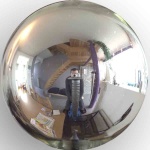PARTICLES: Turbulence and Drag
2 posters
Page 1 of 1
 PARTICLES: Turbulence and Drag
PARTICLES: Turbulence and Drag
This is an offshoot of the discussion here:
http://www.cgpinoy.org/visual-effects-tutorials-vfx-f100/vfx-no1-aircraft-in-near-miss-with-a-building-t3332.htm
This is a quick attempt to demonstrate how to control particle movement using often forgotten but equally important spacewarps. For simplicity, I will be demonstrating using a superspray.
My basic ingredients are:
1. Gravity (depends if you are simulating inspace or outer space (zero gravity) particle movement)
2. Wind - I usually add zero intensity wind with turbulence to break the predictable path of each particles. Imagine a small turbulence as the irregular wind or noise in the environment. This makes a lot of difference in particle movements as it allows you to make wisps, or break the particle into noise disturbances
3. Lastly, DRAG. People forget that travelling matter is moved by energy - and the presence this energy creates a friction or force that counter the same. This translates to objects that burst or travel fast and slowly drag down in proportion to their speed. Imagine this as particles accelerates and decelerates as they reach the maturity of their force.
Here is a video illustration:
A BIT OF TURBULENCE AND DRAG from the vertexwrangler on Vimeo.
Could be better illustrated by using a particle strand. Notice the swirl on the strand on the particles on the middle and the right.
A BIT OF DRAG AND TURBULENCE from the vertexwrangler on Vimeo.
So what is the importance of these basic ingredients? No matter how cool your volumetric setup is, convincing particle movement will always dictate whether the illusion you created is effectve or not.
These concepts were used in the production of the aircraft in near miss cg I mentioned above. For architectural visualizations, the same idea can be used for fountains, leaves or dust in the environment.
http://www.cgpinoy.org/visual-effects-tutorials-vfx-f100/vfx-no1-aircraft-in-near-miss-with-a-building-t3332.htm
This is a quick attempt to demonstrate how to control particle movement using often forgotten but equally important spacewarps. For simplicity, I will be demonstrating using a superspray.
My basic ingredients are:
1. Gravity (depends if you are simulating inspace or outer space (zero gravity) particle movement)
2. Wind - I usually add zero intensity wind with turbulence to break the predictable path of each particles. Imagine a small turbulence as the irregular wind or noise in the environment. This makes a lot of difference in particle movements as it allows you to make wisps, or break the particle into noise disturbances
3. Lastly, DRAG. People forget that travelling matter is moved by energy - and the presence this energy creates a friction or force that counter the same. This translates to objects that burst or travel fast and slowly drag down in proportion to their speed. Imagine this as particles accelerates and decelerates as they reach the maturity of their force.
Here is a video illustration:
A BIT OF TURBULENCE AND DRAG from the vertexwrangler on Vimeo.
Could be better illustrated by using a particle strand. Notice the swirl on the strand on the particles on the middle and the right.
A BIT OF DRAG AND TURBULENCE from the vertexwrangler on Vimeo.
So what is the importance of these basic ingredients? No matter how cool your volumetric setup is, convincing particle movement will always dictate whether the illusion you created is effectve or not.
These concepts were used in the production of the aircraft in near miss cg I mentioned above. For architectural visualizations, the same idea can be used for fountains, leaves or dust in the environment.
 Re: PARTICLES: Turbulence and Drag
Re: PARTICLES: Turbulence and Drag
wow sir V thanks for sharing this tutorial, more power

WenZ3D- CGP Newbie

- Number of posts : 142
Age : 45
Location : Singapore
Registration date : 05/03/2009
Page 1 of 1
Permissions in this forum:
You cannot reply to topics in this forum







